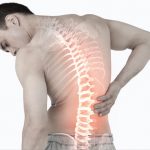
Alternatives to Opioids: Chronic Back Pain Treatment
Opioid medication is not the only solution for chronic back pain relief, Dr. Wong says there are alternatives available to you.
Chronic spinal pain can be completely debilitating, taking a huge emotional and physical toll on a person especially when it seems that there is no end in sight. Often patients who see Dr. Wong have been prescribed opioid medication as a first and only treatment option and have been taking opioids for an extended period of time.
“I was expecting to see a GP and be told how to figure it out, but to be told it was incurable and degenerative and we’ll have to keep you on oxycodone and pregablin for a while was a huge shock.” – Bendigo Advertiser
Whether you are looking at initial treatment options or have been taking opioid medication for an on-going issue for some time, there are alternative treatment options in pain management available to you. And, most importantly, with the right approach we believe you can identify and resolve the root cause of the pain.
Dr. Wong believes most importantly that there needs to be a correct diagnosis of the root cause of the pain as a first step. Alternative treatment options including surgery may fail if the correct cause isn’t identified. And similarly with correct diagnosis, an efficient and effective treatment plan can be mapped out for the patient.
Proper Investigation
‘‘Somehow when it comes to spine, the investigation part is missing. People don’t want to find out the cause. They’re placed on strong pain medication for a long time and I think, in a good proportion of patients, that’s the wrong treatment.’’ – SMH
Proper investigation is key to a correct diagnosis and therefor treatment plan. It should always be a warning signal for patients if there is no detailed investigation into their pain before treatment is prescribed, especially in the case of an opioid prescription. There are a number of investigation methods we can use to determine what the source of the pain may be for chronic spinal pain:
Plain X-Ray – Will identify fractures or any bone abnormalities. An X-Ray will show the alignment of the spine so can be a good first investigation method.
CT Scan – Used for looking at discs in the spine, and will identify herniated discs. A CT Scan will show bone density, blood vessels and tissue.
Nuclear Bone Scan – A bone scan will show abnormal bone growth, infection, metastases, looking in detail at the condition of the bones. A radioactive dye is injected into your bones.
MRI Scan – An MRI takes a clearer picture than an X-Ray or CT scan and is ideal for diagnosing problems in soft tissue like the discs in the spine and/or the spinal cord and nerves.
EOS Scan – Reduced X-ray dose absorbed by the patient in a sitting or standing position when compared to an X-Ray or CT Scan.
Diagnosis & Treatment Plan
With a proper diagnosis comes a treatment plan. Dr. Wong believes that a patient should be presented with the right treatment option specific to their pain.
‘‘It’s not logical that there should be more than one‘ ‘best’ option. There is just the best option – or nothing. ‘Sometimes it has been suggested to a patient that they could have, for example, decompression or fusion. Well, that’s untenable. The only option should be the best treatment.” – The Age
A multi-disciplinary approach may be beneficial however there should be a singular solution to the issue within each realm of treatment, otherwise it becomes a “guessing game”.
Seek a Second Opinion
Oftentimes patients rely solely on their primary care provider to give them the definitive solution to their chronic pain. The issue with this is at times their primary care provider may not be a specialist in the related field so the patient does not receive the correct treatment plan for their issue or the diagnosis isn’t correct.
Dr. Wong strongly suggests seeking a second opinion or asking for a referral from your GP if you don’t feel right about the diagnosis/treatment plan, or if you don’t seem to be making headway over time in your recovery. Sometimes the difference in seeking a second opinion can mean a full recovery. Dr. Wong says the causes of their problems can be very simple to identify sometimes.
‘‘We just do a scan and say, ‘Hang on. There is a disc prolapse. There is nerve compression. That’s why you are having pain.’ The treatment therefore is surgery.’’ – SMH
Medicare rebates are available in cases of chronic pain or illness under the the Chronic Disease Management (CDM) GP service. CDM “enables GPs to plan and coordinate the health care of patients with chronic or terminal medical conditions, including patients with these conditions who require multidisciplinary, team-based care from a GP and at least two other health or care providers”. To find out more visit the CDM site here.
Following a proper diagnosis, there my be a number of different treatment options offered to you…
Alternative Therapies
Physiotherapy – utilisation of manual therapy techniques, soft tissue massage, graded exercise, hydrotherapy and education to allow for safe movement
Acunpuncture – An ancient form of Chinese Medicine using thin needles inserted into the skin. Nerve stimulation through needlework.
Massage – In some cases, regular massage can be extremely beneficial for relieving chronic pain either as a singular treatment option or as part of a multi-disciplinary approach.
Exercise & Weight Loss
While it can seem counter-intuitive, low-impact exercise can be extremely beneficial in strengthening the area around the injury or issue. Pilates, cycling, swimming or hydrotherapy can relieve pressure on the back by strengthening joints and muscles around the spine. Exercise is also very important part of the healing and recovery process from spinal surgery.
It is important however, that you work with a physiotherapist to outline the correct exercise program suitable for your injury or recovery.
Weight loss can be extremely difficult to achieve if encumbered by an injury and/or chronic pain however excess weight can put unnecessary strain on the spine, on the lower back in particular. It may be beneficial to work with an exercise therapist, physiotherapist and dietician/nutritionist to set some achievable weight loss goals working around your pain/injury.
Interventional Procedure: Injections
A spinal injection can provide temporary relief from pain and decrease inflammation around a damaged nerve or joint. There are two types of procedures:
Nerve Block – nerve-numbing injection specific to a group of nerves causing pain blocking feeling which provides pain relief.
Epidural Steroid Injections – decrease swelling and inflammation. This can be beneficial for allowing the area to heal while giving the patient pain relief.
Cognitive Behavioural Therapy
Dr Wong recommends seeing a psychologist for cognitive behavioural therapy if a patient experiences prolonged chronic pain that affects their ability to function or if they have tried a number of other treatment options with no success. Cognitive Behavioural Therapy is a form of psychotherapy which identifies triggers and helps to change negative thoughts and behaviours.
CBT can be a very beneficial part of the treatment process, and can drastically help patients who are coming off using opioids and having trouble regulating their emotions.
“If they continue to suffer then perception of pain changes. It probably becomes heightened and more sensitive. There may be a deal of depression so they can help with that part of the equation too.” – SBS
Surgery
Surgery can be the best treatment option for the client after a proper initial diagnosis, having the potential to save a patient from requiring on-going pain treatment or more importantly from opioid use.
“People need to understand that if you’ve accepted it and been on these drugs for a very long time that technical advances in medicine mean that there could actually be a cure, it’s not just about managing different levels of pain. You might not have to live with the pain at all.” – Bendigo Advertiser
Technological improvements in spinal surgery are greatly improving outcomes and results for patients. Surgeons can be more precise and exact plus the implants and surgical techniques have improved significantly.






